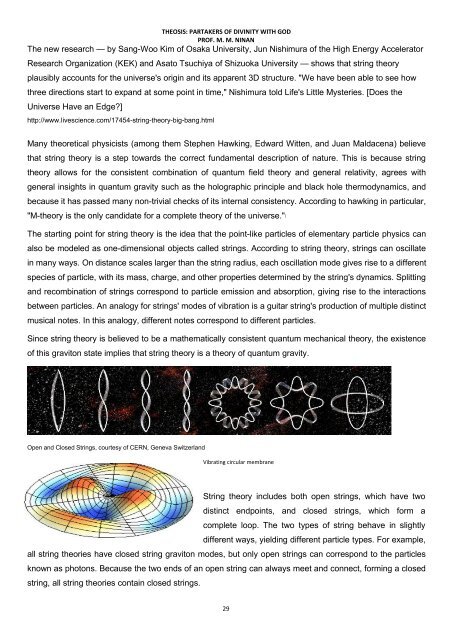Theosis
You also want an ePaper? Increase the reach of your titles
YUMPU automatically turns print PDFs into web optimized ePapers that Google loves.
THEOSIS: PARTAKERS OF DIVINITY WITH GOD<br />
PROF. M. M. NINAN<br />
The new research — by Sang-Woo Kim of Osaka University, Jun Nishimura of the High Energy Accelerator<br />
Research Organization (KEK) and Asato Tsuchiya of Shizuoka University — shows that string theory<br />
plausibly accounts for the universe's origin and its apparent 3D structure. "We have been able to see how<br />
three directions start to expand at some point in time," Nishimura told Life's Little Mysteries. [Does the<br />
Universe Have an Edge?]<br />
http://www.livescience.com/17454-string-theory-big-bang.html<br />
Many theoretical physicists (among them Stephen Hawking, Edward Witten, and Juan Maldacena) believe<br />
that string theory is a step towards the correct fundamental description of nature. This is because string<br />
theory allows for the consistent combination of quantum field theory and general relativity, agrees with<br />
general insights in quantum gravity such as the holographic principle and black hole thermodynamics, and<br />
because it has passed many non-trivial checks of its internal consistency. According to hawking in particular,<br />
"M-theory is the only candidate for a complete theory of the universe." [<br />
The starting point for string theory is the idea that the point-like particles of elementary particle physics can<br />
also be modeled as one-dimensional objects called strings. According to string theory, strings can oscillate<br />
in many ways. On distance scales larger than the string radius, each oscillation mode gives rise to a different<br />
species of particle, with its mass, charge, and other properties determined by the string's dynamics. Splitting<br />
and recombination of strings correspond to particle emission and absorption, giving rise to the interactions<br />
between particles. An analogy for strings' modes of vibration is a guitar string's production of multiple distinct<br />
musical notes. In this analogy, different notes correspond to different particles.<br />
Since string theory is believed to be a mathematically consistent quantum mechanical theory, the existence<br />
of this graviton state implies that string theory is a theory of quantum gravity.<br />
Open and Closed Strings, courtesy of CERN, Geneva Switzerland<br />
Vibrating circular membrane<br />
String theory includes both open strings, which have two<br />
distinct endpoints, and closed strings, which form a<br />
complete loop. The two types of string behave in slightly<br />
different ways, yielding different particle types. For example,<br />
all string theories have closed string graviton modes, but only open strings can correspond to the particles<br />
known as photons. Because the two ends of an open string can always meet and connect, forming a closed<br />
string, all string theories contain closed strings.<br />
29

















